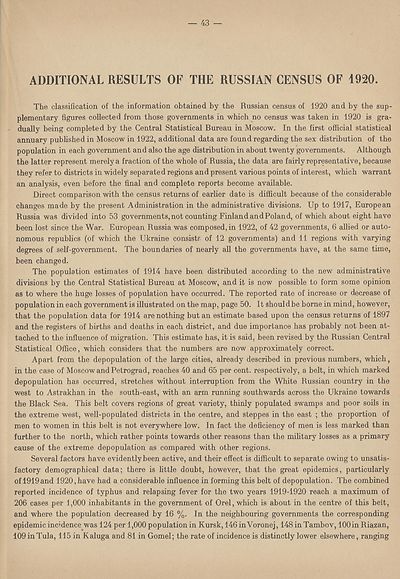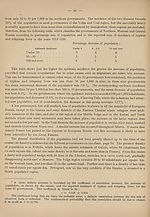Download files
Complete book:
Individual page:
Thumbnail gallery: Grid view | List view

— 43 —
ADDITIONAL RESULTS OF THE RUSSIAN CENSUS OF 1920.
The classification of the information obtained by the Russian census of 1920 and by the sup¬
plementary figures collected from those governments in which no census was taken in 1920 is gra-
- dually being completed by the Central Statistical Bureau in Moscow. In the first official statistical
annuary published in Moscow in 1922, additional data are found regarding the sex distribution of the
population in each government and also the age distribution in about twenty governments. Although
the latter represent merely a fraction of the whole of Russia, the data are fairly representative, because
they refer to districts in widely separated regions and present various points of interest, which warrant
an analysis, even before the final and complete reports become available.
Direct comparison with the census returns of earlier date is difficult because of the considerable
changes made by the present Administration in the administrative divisions. Up to 1917, European
Russia was divided into 53 governments, not counting Finland and Poland, of which about eight have
been lost since the War. European Russia was composed, in 1922, of 42 governments, 6 allied or auto¬
nomous republics (of which the Ukraine consistr of 12 governments) and 11 regions with varying
degrees of self-government. The boundaries of nearly all the governments have, at the same time,
been changed.
The population estimates of 1914 have been distributed according to the new administrative
divisions by the Central Statistical Bureau at Moscow, and it is now possible to form some opinion
as to where the huge losses of population have occurred. The reported rate of increase or decrease of
population in each government is illustrated on the map, page 50. It should be borne in mind, however,
that the population data for 1914 are nothing but an estimate based upon the census returns of 1897
and the registers of births and deaths in each district, and due importance has probably not been at¬
tached to the influence of migration. This estimate has, it is said, been revised by the Russian Central
Statistical Office, which considers that the numbers are now approximately correct.
Apart from the depopulation of the large cities, already described in previous numbers, which,
in the case of Moscow and Petrograd, reaches 40 and 65 per cent, respectively, a belt, in which marked
depopulation has occurred, stretches without interruption from the White Russian country in the
west to Astrakhan in the south-east, with an arm running southwards across the Ukraine towards
the Black Sea. This belt covers regions of great variety, thinly populated swamps and poor soils in
the extreme west, well-populated districts in the centre, and steppes in the east ; the proportion of
men to women in this belt is not everywhere low. In fact the deficiency of men is less marked than
further to the north, which rather points towards other reasons than the military losses as a primary
cause of the extreme depopulation as compared with other regions.
Several factors have evidently been active, and their effect is difficult to separate owing to unsatis¬
factory demographical data; there is little doubt, however, that the great epidemics, particularly
of 1919and 1920,have had a considerable influence in forming this belt of depopulation. The combined
reported incidence of typhus and relapsing fever for the two years 1919-1920 reach a maximum of
206 cases per 1,000 inhabitants in the government of Orel, which is about in the centre of this belt,
and where the population decreased by 16 %. In the neighbouring governments the corresponding
epidemic incidence was 124 per 1,000 population in Kursk, 146 inVoronej, 148 in Tambov, 100in Riazan,
109 in Tula, 115 in Kaluga and 81 in Gomel; the rate of incidence is distinctly lower elsewhere, ranging
ADDITIONAL RESULTS OF THE RUSSIAN CENSUS OF 1920.
The classification of the information obtained by the Russian census of 1920 and by the sup¬
plementary figures collected from those governments in which no census was taken in 1920 is gra-
- dually being completed by the Central Statistical Bureau in Moscow. In the first official statistical
annuary published in Moscow in 1922, additional data are found regarding the sex distribution of the
population in each government and also the age distribution in about twenty governments. Although
the latter represent merely a fraction of the whole of Russia, the data are fairly representative, because
they refer to districts in widely separated regions and present various points of interest, which warrant
an analysis, even before the final and complete reports become available.
Direct comparison with the census returns of earlier date is difficult because of the considerable
changes made by the present Administration in the administrative divisions. Up to 1917, European
Russia was divided into 53 governments, not counting Finland and Poland, of which about eight have
been lost since the War. European Russia was composed, in 1922, of 42 governments, 6 allied or auto¬
nomous republics (of which the Ukraine consistr of 12 governments) and 11 regions with varying
degrees of self-government. The boundaries of nearly all the governments have, at the same time,
been changed.
The population estimates of 1914 have been distributed according to the new administrative
divisions by the Central Statistical Bureau at Moscow, and it is now possible to form some opinion
as to where the huge losses of population have occurred. The reported rate of increase or decrease of
population in each government is illustrated on the map, page 50. It should be borne in mind, however,
that the population data for 1914 are nothing but an estimate based upon the census returns of 1897
and the registers of births and deaths in each district, and due importance has probably not been at¬
tached to the influence of migration. This estimate has, it is said, been revised by the Russian Central
Statistical Office, which considers that the numbers are now approximately correct.
Apart from the depopulation of the large cities, already described in previous numbers, which,
in the case of Moscow and Petrograd, reaches 40 and 65 per cent, respectively, a belt, in which marked
depopulation has occurred, stretches without interruption from the White Russian country in the
west to Astrakhan in the south-east, with an arm running southwards across the Ukraine towards
the Black Sea. This belt covers regions of great variety, thinly populated swamps and poor soils in
the extreme west, well-populated districts in the centre, and steppes in the east ; the proportion of
men to women in this belt is not everywhere low. In fact the deficiency of men is less marked than
further to the north, which rather points towards other reasons than the military losses as a primary
cause of the extreme depopulation as compared with other regions.
Several factors have evidently been active, and their effect is difficult to separate owing to unsatis¬
factory demographical data; there is little doubt, however, that the great epidemics, particularly
of 1919and 1920,have had a considerable influence in forming this belt of depopulation. The combined
reported incidence of typhus and relapsing fever for the two years 1919-1920 reach a maximum of
206 cases per 1,000 inhabitants in the government of Orel, which is about in the centre of this belt,
and where the population decreased by 16 %. In the neighbouring governments the corresponding
epidemic incidence was 124 per 1,000 population in Kursk, 146 inVoronej, 148 in Tambov, 100in Riazan,
109 in Tula, 115 in Kaluga and 81 in Gomel; the rate of incidence is distinctly lower elsewhere, ranging
Set display mode to:
![]() Universal Viewer |
Universal Viewer | ![]() Mirador |
Large image | Transcription
Mirador |
Large image | Transcription
Images and transcriptions on this page, including medium image downloads, may be used under the Creative Commons Attribution 4.0 International Licence unless otherwise stated. ![]()
| League of Nations > Health > Epidemic diseases in Eastern and Central Europe > (49) |
|---|
| Permanent URL | https://digital.nls.uk/190646489 |
|---|
| Shelfmark | LN.III |
|---|---|
| Description | Over 1,200 documents from the non-political organs of the League of Nations that dealt with health, disarmament, economic and financial matters for the duration of the League (1919-1945). Also online are statistical bulletins, essential facts, and an overview of the League by the first Secretary General, Sir Eric Drummond. These items are part of the Official Publications collection at the National Library of Scotland. |
|---|---|
| Additional NLS resources: |
|

